
Step By Step 10 - Techno-Tools
Originally published in Australian Personal Computer magazine, August 1998 Last modified 16-Dec-2014.
You don’t need much in the way of tools to work on computers - a Phillips head screwdriver is all that’s called for in most hardware-installation jobs. But for more involved operations, like adding a new cooling fan or repairing a power cable pinched in the case, you’ll need some extra gear. Fortunately, most of the extra tools for working on computers come in well under $25 (Australian dollars).
Hemostats
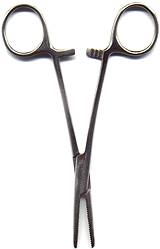
These are the "scissor clamps", sometimes incorrectly called forceps, that surgeons use to clamp off blood vessels. They have serrated jaws and a three-position ratchet closure that gives gigantic gripping power. Hemostats are handy for holding little nuts in place while you screw in their bolts, keeping wires still while you solder them and a host of other tasks. They’re commonly available at electronics stores for less than $10, or for a few bucks less again on eBay.
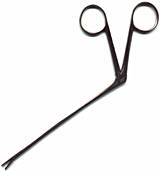
A surgical tool which I find myself using rather more often for computer applications, though, is the "alligator forceps", also known by various names having to do with the bit of the body you're expected to poke them into.
With scissor-ish handles, a long very thin two-part sliding neck and small serrated
jaws at the other end, these can be threaded through a hole less than 4mm wide and open
and close freely, with a fair amount of gripping strength. They’re useful for most of
the things you’d use hemostats for, with less strength but more manoeuvrability. Nothing
beats alligator forceps for gripping and hauling wires though a thicket of other cables.
They’re common medical instruments, but it’s an unusually well-equipped hobby or electronics
store that stocks them. No problem; they're easy to find on both
eBay and
Amazon.
You can also use them for getting the detached fuzzy tip of a cotton bud out of your ear. I'd rather not say how I know this.
PLCC chip puller
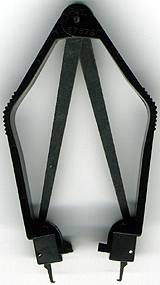
Plastic Leaded Chip Carrier (PLCC) chips are square, and click into a socket which looks something like an above-ground pool for fleas. Getting them out of said socket is challenging, without a PLCC chip extractor. You can do it with a jeweller’s screwdriver, but it’s somewhat nerve-wracking. A PLCC puller clips onto opposite corners of the chip and pops it out with one squeeze. Well under $10 from an electronics store, even cheaper on eBay.
Of course, if you never have to extract a PLCC chip - and there’s a decent chance you never will - don’t bother buying the tool.
Pearl catch
A pearl catch is a vaguely syringe-ish doodad of a thousand names. Press the plunger, and three or more little spring-steel prong-jaws pop out of the other end. These are meant to hold beads and gems and other such jewellery things, but are also quite good at snaring that annoying screw that rattled down into the works of the PC.
It’s even easier to do this with a magnetic pick-up tool, but using magnets around
magnetic media is a general no-no. A pearl catch costs a few bucks from an electronics
store
or on eBay. They're not hard to find
on Amazon,
either.
Threadlock
You know those little hex-headed male-to-female screw thingies that hold on the ports on the back of most PCs? You know how the thumbscrews on the sides of connectors screw into them? You know how they tend to stay attached to the thumbscrew, not the computer, when you unplug the cable? You know how losing both of them lets the port fall off inside the PC case, causing you to say rude words?
There is a solution. Get ye to a hardware store (or, inevitably,
eBay or
Amazon)
and purchase a little bottle of blue Loctite 243 threadlock, or the generically-branded
equivalent. (Loctite is now something of a
genericised trademark
for threadlock.) One drop on the thread of the port screw, give it a few hours to set,
and they’ll never unscrew again without permission.
Don’t get the red high-strength stuff. That’s for things that nobody ever wants to remove again.
(The genericisation of "Loctite" extends to genericisation of threadlock colour, too. If it's blue, it's "removable"; if it's red, it's "permanent".)
Soldering iron
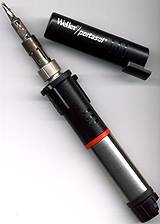
Soldering is easy, and tremendously useful. Splice new connectors onto your power supply. Lengthen that dinky fan cable. Fix the reset-switch lead that got pinched in the case.
A basic mains-powered iron can be had for under $25, plus a few bucks for a roll of solder and a damp tip-cleaning sponge. If you’ve never soldered, practice on random bits of wire until you feel confident about attacking a real job.
(The Web also teems with soldering tutorials.)
If you find yourself having to solder where there isn’t any mains power, consider a butane-powered iron. These give lots of heat - though precise temperature control is difficult, which is a problem for fine work - and run for ages on one squirt from a $10 gas can, which is good for many, many refillings. Expect to pay about $50 for a brand name Portasol butane iron, less for the various clones.
(You can get very cheap soldering irons of both the mains- and gas-powered kind on eBay. Like, six bucks delivered for a gas iron, three bucks for a mains iron. The electric ones are fairly unlikely to burn your house down or kill you, but I still wouldn't trust them, because temperature regulation is important and they probably don't have any. Much better to drop a whole $15 or less on a basic 25-watt mains iron - for electronics soldering, more power is not better - from a reputable local dealer. The ultra-cheap gas irons, on the other hand, are I think worth a shot. Turned down low they shouldn't wreck circuit boards, and they can be a lifesaver if you have to solder something away from electricity. Note that the very cheapest eBay gas "soldering irons" are actually just little flame torches, and clip-on flame-torch heads for standard butane cans. Those clip-on heads are fine for plumbing soldering, but no open-flame torch is any good for soldering electronics.)
Do not use a honking great plumber’s iron for circuit-board soldering. Excessive heat can, and will, lift tracks off the board, making problems worse. A 25-watt iron is plenty.
The iron in the picture is my big Portasol, which is actually a pretty good example of what not to use for fine work. Its maximum power rating is something like 150 watts, and it's hard to accurately set it lower.
Heatshrink tubing
On the subject of soldering, heatshrink is the cure for all those awful wire splices insulated with electrical tape. Heatshrink shrinks to half or less of its starting diameter when subjected to a few hundred degrees (the only real application for flame-torches in electronics work!), and it moulds itself to cover the joint. For secure splices, you can get heatshrink with a hot-melt glue coating on the inside, too.
Available in various sizes and colours for not much from electronics stores and, naturally, eBay.
Wire stripper
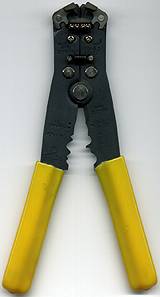
All true electronics hobbyists have a slight V-notch between their front teeth from stripping cables the macho way. This is fine for thin wires, but trying the trick with anything of any size will give joy only to your dentist. So get yourself a proper wire stripper.
The simplest kind of general-purpose wire stripper sort of looks like a pair of scissors, except the jaws don't pass each other - they come together to form a series of graduated holes to match different sizes of wire. You put your wire in the right notch in one blade, you squeeze the handles, the correct-sized cutting hole is formed to slice the insulation but not the copper, and you pull out the stripped wire. They last forever and can be had everywhere for not very much.
Automatic wire strippers adjust themselves to the diameter of the wire, and usually do a good job on everything but very fine wires. They come in two basic shapes. The cheapest ones are sometimes called "T-Rex", for their vague resemblance to the eponymous big lizard. Those work fine for a while; possibly a very long while, for a home user who doesn't strip many wires. (EBay now seems to be flooded with ultra-cheap T-Rexes, which may be made of pure Chinesium and never work in the first place; I don't know, but I suppose you can't complain if you get one for less than four dollars delivered!)
The more expensive automatic strippers look like the picture above or like this (the wiggly bits on the handles are for crimping connectors). They strip a little better than a brand-new T-Rex, and last for a long time.
Cable ties & anchors
The inside of most PCs looks like a drug-addled cable orgy. This is annoying to work with, stuffs up cooling airflow and can jam the CPU fan, which is A Bad Thing. Cable ties are the solution to this, and to almost all other human problems.
Made of nylon, cable or "zip" ties are a ribbed strip with a slide-through, ratchet end. Thread one end through the other, pull it and, with a distinctive zipping sound, the tie cinches down on whatever it’s around, never to let go. Big ones are used by law-enforcement persons as somewhat inhumane quickie handcuffs.
You can get releasable, reusable cable ties, but the regular version is easy enough to cut and very cheap. You can also get self-adhesive anchor blocks the ties thread through, which let you pull your cable bundles up against some case metalwork. Cable ties are available at hardware stores, but cheaper at electronics stores or, you guessed it, eBay.
(You can also get stainless-steel cable ties, which are of course much stronger than the plastic ones, and heatproof. They can thus be used to attach things to hot things, so you can for instance use them to whip up a new exhaust hanger for a car.)
Anti-static strap
Every time you work on a computer, it’s a crapshoot. A static potential of as little as 200 volts is enough to destroy components. A charge that small is too little to feel, and can be accumulated by doing pretty much anything; you don't have to shuffle across nylon carpet in rubber-soled shoes.
If you leave the computer plugged in, to maintain the chassis earth, and touch some bare chassis metal before starting the job and periodically throughout it, the chance of damaging anything is slight. But for more security, use an anti-static strap that fastens around your wrist or ankle and clips to the PC chassis. They're essentially free on eBay.
(At some point, some fool invented the "cordless anti-static wrist strap". These do not work at all.)
Torx drivers
Some hard disks and laptops are held together with Torx screws, which have a funny six-pointed-star shaped hole in the head. What this says is "Do not undo these screws". This is a fair statement; hard drives are, basically, unserviceable, and opening one and letting in even a few tiny motes of dust is a recipe for disaster. A careful home user can also fix a laptop, but laptop manufacturers know that most of their customers are not careful enough.
But maybe you want to swap the controller board on a drive that contains the only copy of some invaluable data (since the board probably costs more as a spare part than a whole new drive, that data would have to be invaluable). Or you want to clean your laptop fan. Or maybe you’ve got a dead hard drive and you just want to get the pretty platters out of it and hang them on your wall. By the way, I strongly recommend this latter course of action - hard disk platters make fine decorations, and also serve as a warning to other drives that may be considering misbehaviour.
In a pinch, you can undo Torx screws with an Allen (hex) key of the appropriate size, but you’re meant to use the proper star-shaped driver. If the hard drive was made by a company really determined to keep you out, the screws may be "tamperproof Torx", with a pin in the middle of the screwhead to stop the driver engaging. Naturally, special tamperproof Torx drivers are available, and they work fine on regular Torx screws too.
If Torx screws are at the bottom of a narrow well, you'll need an actual set of Torx drivers to remove them. Usually, though, you'll be fine with a set of hex bits including a few Torx sizes, for an interchangeable-quarter-inch-tip screwdriver.
Maglites

A decent torch (flashlight, to you non-Queen's English types) is essential for PC twiddling. Even when you've got the blighters on a well-lit workbench there'll be something in a cranny you can't read, and the dedicated computer-tweaker is likely to spend a depressing amount of time peering at things in the gloom beneath a desk.
You don't want a five quadrillion candlepower searchlight for poking around in PCs; you want a small, durable, reasonably bright penlight. There are about a zillion different makes of penlight, and any of the cheapies will do in a pinch, but the most popular quality ones are the Maglite range, made by Mag Instrument of California and available in camping and department stores the world over. The ISO standard small Maglite is the 2-AA-cell Mini Maglite, but the tiny single-AAA-cell Solitaire is great too; it's not as bright, but it's so small it can live in your pocket.
Mag also make a double-AAA model and various C and D cell units as well, up to the mighty six-D-cell monster which less civilised souls than I might refer to as the Rodney King Signature Edition.
It is generally accepted that this model is unsuitable for computer service work, though it makes an admirable LART.
[The above section was written so long ago that LED flashlights were not yet an option! Today, of course, there are zillions of cheap, super-bright LED lights that're more than good enough for almost all purposes. The ubiquitous stubby little 9-LED lights that run from three AAA cells are well worth the almost-no-dollars that they cost. For fixing-things purposes, a cheap LED headlamp is handier.]
Tools to avoid
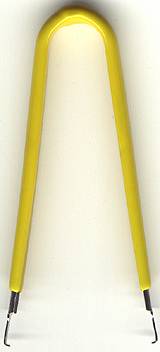
Electronics stores often sell little kits of "computer service tools", which include among other things DIP (Dual Inline Package - the standard chip layout with a row of legs on either side of a rectangular package) chip pullers and inserters. The pullers look vaguely like tongs, while the inserters have a holder for a chip at one end and a syringe-ish plunger at the other to shove it into its socket.
Avoid both of these tools like the plague.
There was a big dip, no pun intended, in the use of these awful things when people no longer needed to insert and remove DIP RAM and BIOS and even CPU chips in their personal computers any more. But now that microcontrollers are childrens' toys, these terrible tools may experience a renaissance.
When you’re hauling away on a DIP chip puller, it’s easy for one end of the chip to pop out before the other, and before you know it you’ve got a chip standing perpendicular to the board with its last pair of pins bent 90 degrees but still plugged in, and all of the other pins also bent according to their proximity to the still-connected end. And when you bring your thumb down on the plunger of a DIP inserter, it’s easy to misalign the chip slightly and bend each and every pin in half.
Remove DIP chips by gently levering each end in turn with a small flathead screwdriver, raising each end a little at a time until it comes free without forcing. And insert them by hand. It’s easy.
While I’m sounding off, think twice about using an electric screwdriver on your PC. For taking screws out, electric screwdrivers are fine - provided you don’t use them on a seized screw or with the wrong sized bit, whereupon they can strip a screw head in a second.
Most electric screwdrivers, however, don't have a torque control clutch, so they make it easy to overtighten PC screws (cordless drills normally do have clutches, these days; set the torque to minimum and on all but the finest screws, you'll be fine).
In all but the most expensive PC cases, the screws bite into poorly tapped holes in thin sheet metal. So it’s easy to ream the hole, assuming the screw’s a good one, or wreck the screw, if it isn’t.

